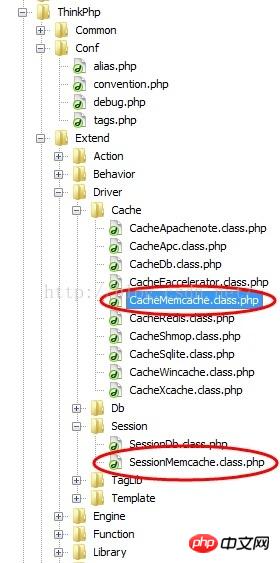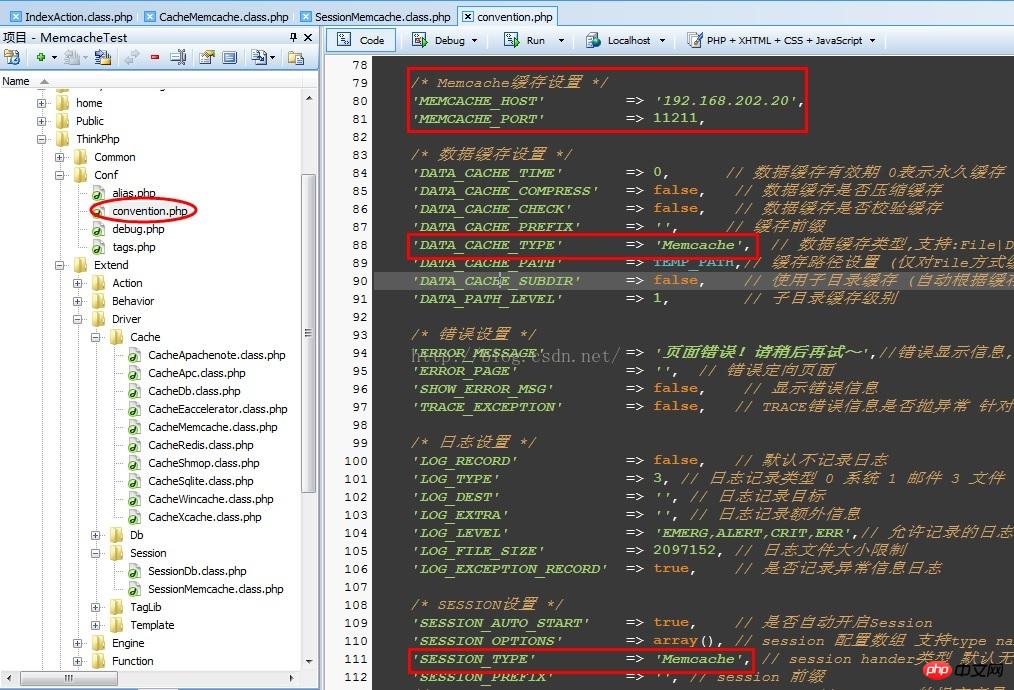Detailed explanation of php distributed deployment examples
Mar 12, 2018 am 11:29 AMIn ordinary Web development, the common mode is that after the user logs in, the login status information is stored in the Session, some of the user's commonly used hot data is stored in the file cache, and the attachment information uploaded by the user is stored in a directory on the Web server. . This method is very convenient to use and fully capable for general Web applications. But for high-concurrency enterprise-level websites, it cannot handle it. Web clusters need to be used to achieve load balancing.
After deploying using the Web cluster method, the first thing to adjust is the user status information and attachment information. User status can no longer be saved to the Session, the cache cannot use the file cache of the local Web server, and attachments cannot be saved on the Web server. Because it is necessary to ensure that the status of each web server in the cluster is completely consistent. Therefore, user status, cache, etc. need to be saved to a dedicated cache server, such as Memcache. Attachments need to be saved to cloud storage, such as Qiniu Cloud Storage, Alibaba Cloud Storage, Tencent Cloud Storage, etc.
This article takes the ThinkPHP development framework as an example to explain how to set up and save Session, cache, etc. to the Memcache cache server.
Download the cached Memcache processing class and place it in the Thinkphp\Extend\Driver\Cache directory; download the Session Memcache processing class and place it in the Thinkphp\Extend\Driver\Session directory. As shown in the figure below:

Modify the configuration file, adjust the Session and cache, and record them to the Memcache server. Open ThinkPHP\Conf\convention.PHP, add configuration items:
/* Memcache緩存設(shè)置 */ 'MEMCACHE_HOST' => '192.168.202.20', 'MEMCACHE_PORT' => 11211,
Modify the data cache to Memcache:
'DATA_CACHE_TYPE'
=>
'Memcache'
,Modify Session to Memcache:
'SESSION_TYPE' => 'Memcache',
As shown below:

Because there are many types of cloud storage, attachments are stored on cloud storage, so I won’t go into details. Just parameterize the SDK provided by each cloud storage. After the above modifications, the Web server can be deployed in a distributed manner.
Attachment 1: CacheMemcache.class.php
<?php
// +----------------------------------------------------------------------
// | ThinkPHP [ WE CAN DO IT JUST THINK IT ]
// +----------------------------------------------------------------------
// | Copyright (c) 2006-2012 http://thinkphp.cn All rights reserved.
// +----------------------------------------------------------------------
// | Licensed ( http://www.apache.org/licenses/LICENSE-2.0 )
// +----------------------------------------------------------------------
// | Author: liu21st <liu21st@gmail.com>
// +----------------------------------------------------------------------
defined('THINK_PATH') or exit();
/**
* Memcache緩存驅(qū)動
* @category Extend
* @package Extend
* @subpackage Driver.Cache
* @author liu21st <liu21st@gmail.com>
*/
class CacheMemcache extends Cache {
/**
* 架構(gòu)函數(shù)
* @param array $options 緩存參數(shù)
* @access public
*/
function __construct($options=array()) {
if ( !extension_loaded('memcache') ) {
throw_exception(L('_NOT_SUPPERT_').':memcache');
}
$options = array_merge(array (
'host' => C('MEMCACHE_HOST') ? C('MEMCACHE_HOST') : '127.0.0.1',
'port' => C('MEMCACHE_PORT') ? C('MEMCACHE_PORT') : 11211,
'timeout' => C('DATA_CACHE_TIMEOUT') ? C('DATA_CACHE_TIMEOUT') : false,
'persistent' => false,
),$options);
$this->options = $options;
$this->options['expire'] = isset($options['expire'])? $options['expire'] : C('DATA_CACHE_TIME');
$this->options['prefix'] = isset($options['prefix'])? $options['prefix'] : C('DATA_CACHE_PREFIX');
$this->options['length'] = isset($options['length'])? $options['length'] : 0;
$func = $options['persistent'] ? 'pconnect' : 'connect';
$this->handler = new Memcache;
$options['timeout'] === false ?
$this->handler->$func($options['host'], $options['port']) :
$this->handler->$func($options['host'], $options['port'], $options['timeout']);
}
/**
* 讀取緩存
* @access public
* @param string $name 緩存變量名
* @return mixed
*/
public function get($name) {
N('cache_read',1);
return $this->handler->get($this->options['prefix'].$name);
}
/**
* 寫入緩存
* @access public
* @param string $name 緩存變量名
* @param mixed $value 存儲數(shù)據(jù)
* @param integer $expire 有效時(shí)間(秒)
* @return boolen
*/
public function set($name, $value, $expire = null) {
N('cache_write',1);
if(is_null($expire)) {
$expire = $this->options['expire'];
}
$name = $this->options['prefix'].$name;
if($this->handler->set($name, $value, 0, $expire)) {
if($this->options['length']>0) {
// 記錄緩存隊(duì)列
$this->queue($name);
}
return true;
}
return false;
}
/**
* 刪除緩存
* @access public
* @param string $name 緩存變量名
* @return boolen
*/
public function rm($name, $ttl = false) {
$name = $this->options['prefix'].$name;
return $ttl === false ?
$this->handler->delete($name) :
$this->handler->delete($name, $ttl);
}
/**
* 清除緩存
* @access public
* @return boolen
*/
public function clear() {
return $this->handler->flush();
}
}<?php
// +----------------------------------------------------------------------
// |
// +----------------------------------------------------------------------
// | Copyright (c) 2013-
// +----------------------------------------------------------------------
// | Licensed ( http://www.apache.org/licenses/LICENSE-2.0 )
// +----------------------------------------------------------------------
// | Author: richievoe <richievoe@163.com>
// +----------------------------------------------------------------------
/**
* 自定義Memcache來保存session
*/
Class SessionMemcache{
//memcache對象
private $mem;
//SESSION有效時(shí)間
private $expire;
//外部調(diào)用的函數(shù)
public function execute(){
session_set_save_handler(
array(&$this,'open'),
array(&$this,'close'),
array(&$this,'read'),
array(&$this,'write'),
array(&$this,'destroy'),
array(&$this,'gc')
);
}
//連接memcached和初始化一些數(shù)據(jù)
public function open($path,$name){
$this->expire = C('SESSION_EXPIRE') ? C('SESSION_EXPIRE') :ini_get('session.gc_maxlifetime');
$this->mem = new Memcache;
return $this->mem->connect(C('MEMCACHE_HOST'), C('MEMCACHE_PORT'));
}
//關(guān)閉memcache服務(wù)器
public function close(){
return $this->mem->close();
}
//讀取數(shù)據(jù)
public function read($id){
$id = C('SESSION_PREFIX').$id;
$data = $this->mem->get($id);
return $data ? $data :'';
}
//存入數(shù)據(jù)
public function write($id,$data){
$id = C('SESSION_PREFIX').$id;
//$data = addslashes($data);
return $this->mem->set($id,$data,0,$this->expire);
}
//銷毀數(shù)據(jù)
public function destroy($id){
$id = C('SESSION_PREFIX').$id;
return $this->mem->delete($id);
}
//垃圾銷毀
public function gc(){
return true;
}
}
?>
Detailed explanation of distributed deployment examples for ThinkPHP projects
hadoop 2.6.0 Pseudo-distributed deployment installation example tutorial
PHP extended Memcache distributed deployment solution_PHP
The above is the detailed content of Detailed explanation of php distributed deployment examples. For more information, please follow other related articles on the PHP Chinese website!

Hot AI Tools

Undress AI Tool
Undress images for free

Undresser.AI Undress
AI-powered app for creating realistic nude photos

AI Clothes Remover
Online AI tool for removing clothes from photos.

Clothoff.io
AI clothes remover

Video Face Swap
Swap faces in any video effortlessly with our completely free AI face swap tool!

Hot Article

Hot Tools

Notepad++7.3.1
Easy-to-use and free code editor

SublimeText3 Chinese version
Chinese version, very easy to use

Zend Studio 13.0.1
Powerful PHP integrated development environment

Dreamweaver CS6
Visual web development tools

SublimeText3 Mac version
God-level code editing software (SublimeText3)

Hot Topics
 A Simple Guide to PHP Setup
Jul 18, 2025 am 04:25 AM
A Simple Guide to PHP Setup
Jul 18, 2025 am 04:25 AM
The key to setting up PHP is to clarify the installation method, configure php.ini, connect to the web server and enable necessary extensions. 1. Install PHP: Use apt for Linux, Homebrew for Mac, and XAMPP recommended for Windows; 2. Configure php.ini: Adjust error reports, upload restrictions, etc. and restart the server; 3. Use web server: Apache uses mod_php, Nginx uses PHP-FPM; 4. Install commonly used extensions: such as mysqli, json, mbstring, etc. to support full functions.
 Commenting Out Code in PHP
Jul 18, 2025 am 04:57 AM
Commenting Out Code in PHP
Jul 18, 2025 am 04:57 AM
There are three common methods for PHP comment code: 1. Use // or # to block one line of code, and it is recommended to use //; 2. Use /.../ to wrap code blocks with multiple lines, which cannot be nested but can be crossed; 3. Combination skills comments such as using /if(){}/ to control logic blocks, or to improve efficiency with editor shortcut keys, you should pay attention to closing symbols and avoid nesting when using them.
 Quick PHP Installation Tutorial
Jul 18, 2025 am 04:52 AM
Quick PHP Installation Tutorial
Jul 18, 2025 am 04:52 AM
ToinstallPHPquickly,useXAMPPonWindowsorHomebrewonmacOS.1.OnWindows,downloadandinstallXAMPP,selectcomponents,startApache,andplacefilesinhtdocs.2.Alternatively,manuallyinstallPHPfromphp.netandsetupaserverlikeApache.3.OnmacOS,installHomebrew,thenrun'bre
 Writing Effective PHP Comments
Jul 18, 2025 am 04:44 AM
Writing Effective PHP Comments
Jul 18, 2025 am 04:44 AM
Comments cannot be careless because they want to explain the reasons for the existence of the code rather than the functions, such as compatibility with old interfaces or third-party restrictions, otherwise people who read the code can only rely on guessing. The areas that must be commented include complex conditional judgments, special error handling logic, and temporary bypass restrictions. A more practical way to write comments is to select single-line comments or block comments based on the scene. Use document block comments to explain parameters and return values at the beginning of functions, classes, and files, and keep comments updated. For complex logic, you can add a line to the previous one to summarize the overall intention. At the same time, do not use comments to seal code, but use version control tools.
 Improving Readability with Comments
Jul 18, 2025 am 04:46 AM
Improving Readability with Comments
Jul 18, 2025 am 04:46 AM
The key to writing good comments is to explain "why" rather than just "what was done" to improve the readability of the code. 1. Comments should explain logical reasons, such as considerations behind value selection or processing; 2. Use paragraph annotations for complex logic to summarize the overall idea of functions or algorithms; 3. Regularly maintain comments to ensure consistency with the code, avoid misleading, and delete outdated content if necessary; 4. Synchronously check comments when reviewing the code, and record public logic through documents to reduce the burden of code comments.
 Tips for Writing PHP Comments
Jul 18, 2025 am 04:51 AM
Tips for Writing PHP Comments
Jul 18, 2025 am 04:51 AM
The key to writing PHP comments is to clarify the purpose and specifications. Comments should explain "why" rather than "what was done", avoiding redundancy or too simplicity. 1. Use a unified format, such as docblock (/*/) for class and method descriptions to improve readability and tool compatibility; 2. Emphasize the reasons behind the logic, such as why JS jumps need to be output manually; 3. Add an overview description before complex code, describe the process in steps, and help understand the overall idea; 4. Use TODO and FIXME rationally to mark to-do items and problems to facilitate subsequent tracking and collaboration. Good annotations can reduce communication costs and improve code maintenance efficiency.
 Learning PHP: A Beginner's Guide
Jul 18, 2025 am 04:54 AM
Learning PHP: A Beginner's Guide
Jul 18, 2025 am 04:54 AM
TolearnPHPeffectively,startbysettingupalocalserverenvironmentusingtoolslikeXAMPPandacodeeditorlikeVSCode.1)InstallXAMPPforApache,MySQL,andPHP.2)Useacodeeditorforsyntaxsupport.3)TestyoursetupwithasimplePHPfile.Next,learnPHPbasicsincludingvariables,ech
 Mastering PHP Block Comments
Jul 18, 2025 am 04:35 AM
Mastering PHP Block Comments
Jul 18, 2025 am 04:35 AM
PHPblockcommentsareusefulforwritingmulti-lineexplanations,temporarilydisablingcode,andgeneratingdocumentation.Theyshouldnotbenestedorleftunclosed.BlockcommentshelpindocumentingfunctionswithPHPDoc,whichtoolslikePhpStormuseforauto-completionanderrorche






